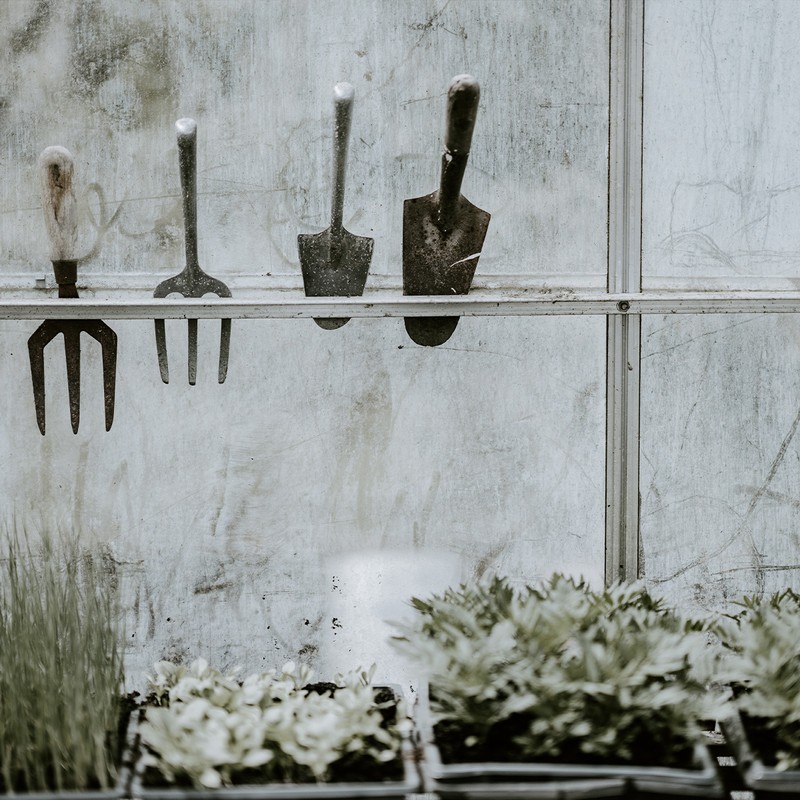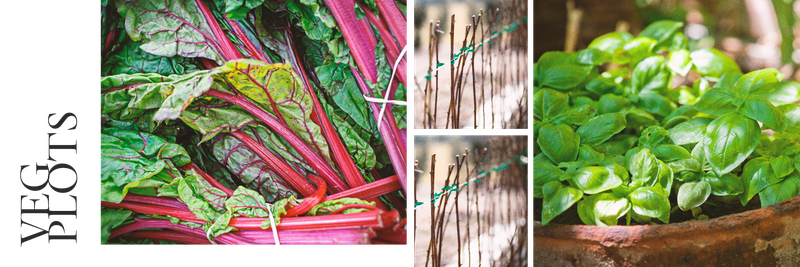
What To Plant In A Garden Now
Words: Georgina Blaskey


WINDOW BOXES AND PLANTERS
Bedding Plants
“The best plants to use for window boxes and patio containers are what’s known as bedding plants,” says Frannie Liddle, co-founder of Window Fleur, the first ready-planted window box subscription club. “These are small plants that usually only last for a specific season. They are fast growing and used for temporary decorative seasonal displays, which makes them a perfect choice for a window box.”
Heather & Campanulas
That said, with February and early March still prone to the old cold snap and morning frosts, it’s likely only the hardiest bedding plants will survive. Frannie advises: “Our first choice at this time of year would be a variety of heather called ‘Erica Darleyensis’ – it's so delicate and pretty, yet super resilient. It also require slittle in the way of watering, too – once a week at most – especially with the wet winters we’ve been having. Then, as soon as we reach early spring, we’d suggest ‘Campanulas’, as these come in purple and white varieties, and again, are very hardy. They have lots of flower heads, so they can create a big splash of colour.”
Daisies, Tulips & Narcicisus
As soon as the weather starts to warm up, you have a lot more choice when it comes to bedding plants, Frannie explains. “A lovely combination would be some pompom ‘Bellis Daisies’, paired with elegant ‘Dwarf Tulips’. And nothing screams spring like mini daffodils narccisus ‘Tête-à-Tête’,” she adds.
The Pitfalls To Avoid…
The biggest mistake people make is planting plants which aren’t hardy enough to survive late frosts, as well as over-watering them. So be sure to select plants suited for the current season to get the most from them. Consider how much time you want to give to your plants, too, says Frannie. “When selecting which ones to plant, pick low maintenance varieties,” she advises. “When planted with the right species, window boxes and containers should be very low maintenance. Unless you have a self-watering container, then watering and deadheading them (to increase the flower production) is really all you need to do.”
/https%3A%2F%2Fsw18.sheerluxe.com%2Fsites%2Fsheerluxe%2Ffiles%2Farticles%2F2021%2F02%2Fsmallgarden2.png?itok=0U0RmX2m)
SMALL GARDENS
Begonias, Dahlias & Gladioli
When it comes to filling up a patio space with a variety of pots bursting with colour and foliage, the experts say it’s crucial to plan ahead. “Summer flowering bulbs are available now,” says Dobbies horticultural director, Marcus Eyles. “Perfect for garden borders and patio containers, alike, you can choose from begonias, dahlias and gladioli – among others – to reap some fabulous summer colour, with very little effort.”
Primroses, Violas & Bellis
Refresh patio pots and hanging baskets with a cheerful display of early season primroses, violas and bellis, planting potted spring bulbs in the gaps for an extra burst of colour. “One of the most economical ways to ensure your tubs and baskets are full of cascading colour is to grow your own bedding plants from young plants, potted up into small pots to grow in a warm frost-free greenhouse, conservatory or on a windowsill, until all risk of frost has passed,” says Marcus.
Lilies
While heavy snowfall will ultimately stop the growth of some plants, others can withstand the chill. “For example, lilies are hardy, can survive outdoors and flower well in cooler conditions,” says gardening expert Heather Barrigan from MyJobQuote.co.uk. “However, be careful not to over-water your lilies. It may be necessary to wrap the containers with bubble wrap in extreme conditions to protect against frost until spring, too.”
The Pitfalls To Avoid…
“Planning is key to help keep garden plants alive when it’s cold outside,” says Marcus. “When planting, check the hardiness of your plants, relative to the area of the country you live in, and make sure it’s a suitable match. By having this understanding, you’ll also be more mindful of changing temperatures and what plants can and can’t tolerate.”
Keep an eye on these fluctuating temperatures, checking both the day and nighttime variations. “If your plants won’t stand that much frost, bring them into a protected place, like a greenhouse, porch or conservatory. If you can’t or it’s planted in the ground, then use a frost protection fleece. Very cold winds are most damaging to evergreen plants, as it burns the foliage,” adds Marcus.
/https%3A%2F%2Fsw18.sheerluxe.com%2Fsites%2Fsheerluxe%2Ffiles%2Farticles%2F2021%2F02%2Flargegardensfinal.png?itok=HQSrbbyz)
LARGER GARDENS
Snowdrops
Marcus suggests the following for those who love snowdrops: “Clumps of snowdrops that have finished flowering can be lifted at the end of the month while they are still in leaf, carefully split into smaller clumps, then replanted to the same depth in their newly chosen positions.”
Love-In-The-Mist, English Marigold, Wisiteria & Clematis
“Easy to grow hardy annuals, such as Dobbies' much-loved Love-In-The-Mist or English Marigold can be sown now, and sprinkled straight into the borders where they are intended to flower,” Marcus adds. It’s also a good time to cut and take care of certain established plants to encourage future growth, too. “Prune wisteria to encourage strong flower buds by cutting side shoots back to just two or three buds,” Marcus says. “Cut back the stems of late summer and autumn flowering clematis to the lowest pair of strong buds to encourage strong new stems come spring.”
The Pitfalls To Avoid…
Before gardening in winter, ensure your garden is prepared to prevent any damage, and guard against pests. “This can be done by removing old plant debris, digging over the soil to expose any pests and clearing the ground under trees,” says Heather.

VEGETABLE PLOTS
Potatoes
Winter is the perfect time to start ‘chitting’ your potatoes. “Chitting simply means to encourage the seed potatoes to sprout before planting, which can be done on a windowsill indoors,” explains Heather. “To ‘chit’ will take approximately two to three weeks, and the best way to do so is to place your seed potatoes in an egg carton, in a light and cool place. After the sprouts reach an inch in height, they're ready to be planted in the ground outside.”
Basil
No matter how cold it is, you can have year-round herbs via a windowsill garden. “Grow basil in well-drained, nutrient-rich soil and place it in a sheltered position out of direct sunlight,” suggests Heather. “To achieve a quality crop, grow basil in a container to avoid rotting, and allow for frequent airflow.” The same technique can be applied to other herbs, which thrive well in the cold, such as parsley and coriander. By growing herbs in containers, this will keep aggressive spreaders, such as mint and lemon balm, under control and away from garden beds.
Berries
As long as the soil isn’t frozen or waterlogged, you can grow a variety of berries in winter, too. These include raspberry canes, bare-root strawberry plants, blueberry bushes and blackberries. Heather says: “In most cases, berries are not seriously damaged by frost. However, new growth can be hindered by winter conditions, so make sure you prune off the damaged parts of the plant. To avoid having to do this, choose a cultivar that blooms later in spring.”
Cut spent canes of autumn fruiting raspberries to the floor to encourage new stems to grow in their place, planting new freshly potted raspberry canes for a succession of ready-to-pick berries from early summer to autumn, suggests Marcus.
Rhubarb
“When planting rhubarb, remember to allow enough room for them to develop to their full size. Add a thick layer of farmyard manure around your new plant to help retain moisture and keep weeds at bay, too,” says Marcus.
Peas
With little protection over the darkest months, peas will still grow in spring and continue to develop thereafter. “For winter, it is worth having a few pea sticks either side of the row to keep them off the soil and away from pests,” Heather advises. “Peas can even be grown in spare guttering with drainage holes drilled in the bottom. Water the plants when they start to flower and two weeks after. Add a thick mulch around the base of the plants to help prevent the soil drying out.”
The Pitfalls to Avoid…
Cabbage and cauliflower are cool-season plants, but they take a little planning to thrive in winter conditions. “Care must be taken not to get the young leaves exposed to frost, as they will quickly wither,” warns Heather. “Winter crops also need frequent irrigation, so the area doesn’t become overly soggy. Cabbage and cauliflower that grow in overly wet soil tend to split, so ensure the seedbed has good drainage to prevent damage to the roots. This can be achieved by growing your cabbage and cauliflower in containers, as opposed to pots.”
Not all plants will flourish in the cold, but it’s worth remembering the colder months provide the perfect opportunity to get a head start on spring. Ensure your plot is prepared to prevent any damage and guard against pests first and foremost.
DISCLAIMER: We endeavour to always credit the correct original source of every image we use. If you think a credit may be incorrect, please contact us at info@sheerluxe.com.

